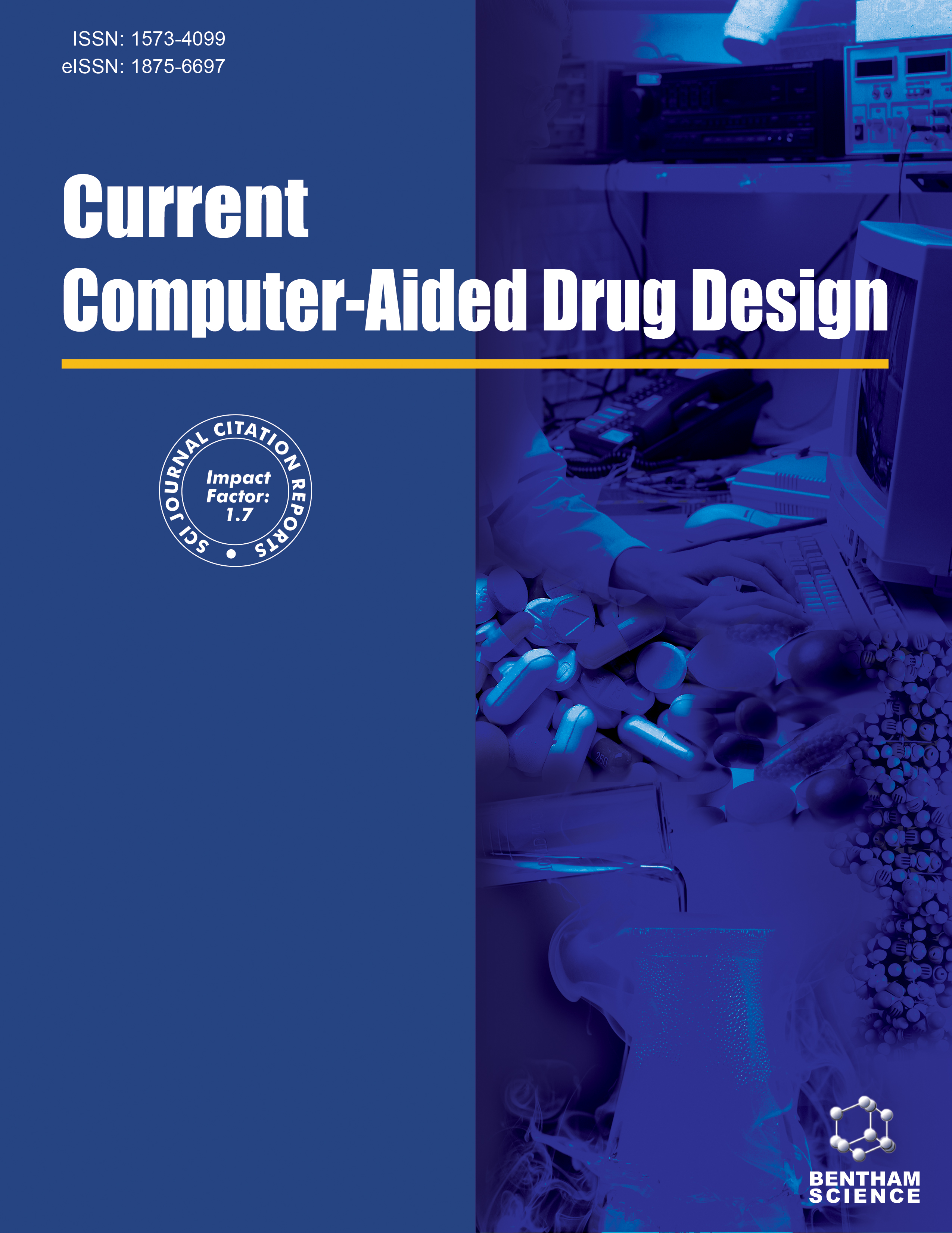- Home
- A-Z Publications
- Current Computer - Aided Drug Design
- Previous Issues
- Volume 14, Issue 2, 2018
Current Computer - Aided Drug Design - Volume 14, Issue 2, 2018
Volume 14, Issue 2, 2018
-
-
Structural Basis of Antisickling Effects of Selected FDA Approved Drugs: A Drug Repurposing Study
More LessAuthors: Olujide O. Olubiyi, Maryam O. Olagunju, James O. Oni and Abidemi O. OlubiyiIntroduction: Sickle cell disease is characterized by a point mutation involving substitution of glutamic acid at position 6 to valine. Encoded in this hydrophobic mutation is both an intrinsic capacity for the beta globin molecules to assemble into thermodynamically favoured polymeric states as well as a rational way of interrupting the aggregation. Methods: In this work, starting with a theoretical model that employs occlusive bin Read More
-
-
-
Computational Exploration of Natural Compounds to Target Cytosolic Phospholipase A 2 Protein: A Novel Therapeutic Target for Spinal Cord Injury
More LessAuthors: Hongwu Fan, Shengqun Wang, Qiheng Zhao and Zhigang QinBackground: Cytosolic Phospholipase A2 (cPLA2), an important isoform of PLA2 that mediates the release of arachidonic acid, plays a role in the pathogenesis of Spinal Cord Injury (SCI). The expression and activation of Cpla2 are significantly higher in SCI, leading to neuronal death in spinal cord tissue. Novel strategies are needed to substantially reverse the effect of cPLA2 activation; one such strategy is inhibiting cPLA2 by j Read More
-
-
-
Exploring the Influence of Mutation on Transthyretin Aggregation in Heart Disease
More LessAuthors: Ankita Sharma, Monu and Sagarika BiswasBackground: Transthyretin (TTR) is the transporter protein (55 kDa) that carries retinolbinding protein and Thyroxin (T4) in its functional tetramer form. Presence of the mutation in this protein (TTR) may lead to the dissociation of tetramers to monomer which unfolds and self-associates to form amyloid aggregates. Aggregation of this protein has been found to be associated with various lifethreatening disorders such as Cor Read More
-
-
-
Designing Ligands for Leishmania, Plasmodium, and Aspergillus N-Myristoyl Transferase with Specificity and Anti-target-safe Virtual Libraries
More LessBackground: Leishmaniasis, malaria, and fungal diseases are burdens on individuals and populations and can present severe complications. Easily accessible chemical treatments for these diseases are increasingly sought-after. Targeting the parasite N-myristoyl transferase while avoiding the human enzyme and other anti-targets may allow the prospect of compounds with pan-activity against these diseases, which would simpl Read More
-
-
-
Synthesis, Structural Characterization and Docking Studies of Sulfamoyl-Phenyl Acid Esters as Dipeptidyl Peptidase-IV Inhibitors
More LessBackground: Diabetes mellitus is a major worldwide health concern that has several serious complications including retinopathy, neuropathy, nephropathy and macrovascular diseases. Objective: Dipeptidyl peptidase-IV (DPP-IV) inhibitors, gliptins, are a new class of antidiabetic agents that potentiate the action of incretins in decreasing the blood glucose levels. Methods: In the present study, synthesis and characterization of Read More
-
-
-
Quantitative Structure-Activity Relationship Study of Betulinic Acid Derivatives Against HIV using SMILES-based Descriptors
More LessBackground: Human Immunodeficiency Virus (HIV) is the causative agent of Acquired Immunodeficiency Syndrome (AIDS) that imposes a global health burden. Therefore, HIV therapeutic agents have been discovery and development. Objective: To construct Quantitative-structure Activity Relationship (QSAR) models of betulinic acid derivatives with anti-HIV activity using Simplified Molecular-Input Line-Entry System (SMILES Read More
-
-
-
Finding Novel Anti-carcinomas Compounds by Targeting SFRP4 Through Molecular Modeling, Docking and Dynamic Simulation Studies
More LessAuthors: M. Hassan, M. Azhar, Q. Abbas, H. Raza, A.A. Moustafa, S. Shahzadi, Z. Ashraf and S.Y. SeoBackground: Secreted Frizzled-Related Protein 4 (SFRP4) is a glycoprotein that acts as a competitor of both canonical and non-canonical Wnt pathways. SFRP4 is mostly expressed in ovary and plays a significant role as a target molecule to cure ovarian carcinoma. Objective: Multiple chemical agonists are being used to cure ovary melanoma. We are interested in theoretically analyzing the compounds through comput Read More
-
Volumes & issues
-
Volume 21 (2025)
-
Volume 20 (2024)
-
Volume 19 (2023)
-
Volume 18 (2022)
-
Volume 17 (2021)
-
Volume 16 (2020)
-
Volume 15 (2019)
-
Volume 14 (2018)
-
Volume 13 (2017)
-
Volume 12 (2016)
-
Volume 11 (2015)
-
Volume 10 (2014)
-
Volume 9 (2013)
-
Volume 8 (2012)
-
Volume 7 (2011)
-
Volume 6 (2010)
-
Volume 5 (2009)
-
Volume 4 (2008)
-
Volume 3 (2007)
-
Volume 2 (2006)
-
Volume 1 (2005)
Most Read This Month
Article
content/journals/cad
Journal
10
5
false
en


